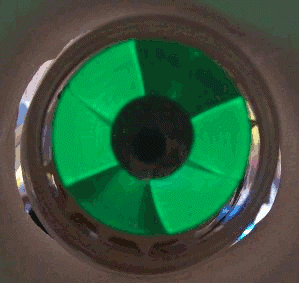Meet the Magic Eye Vacuum Tube
Vacuum tubes ruled electronics for several decades and while you might think of them as simple devices analogous to a transistor or FET, there were many special types. We’re all familiar with nixie tubes that act as numeric displays, and there are other specialty tubes that work as a photomultiplier, to detect radiation, or even generate microwaves. But one of the most peculiar and distinctive specialty tubes has an intriguing name: a magic eye tube. When viewed from the top, you see a visual indication that rotates around a central point, the out ring glowing while the inner is dark, like an iris and pupil.

The indicator part of this virtual meter took the form of a shadow. Based on the applied signal, the shadow would be larger or smaller. Many tubes also contained a triode which would drive the tube from a signal.
There’s a great web site full of information on these venerable tubes and it has examples of these tubes appearing in plenty of things. They frequently appeared in service equipment, radios, and tape recorders. They even appeared in pro audio equipment like the Binson Echorec echo-delay unit.
Before the Magic Eye
The magic eye actually replaced an even older technology: neon bulbs. Modified neon bulbs appeared in the early 1930s as Tune-A-Lite produced by a company named Duovac. You can read more about them at the Radio Museum. Interestingly, some of these had a mute output that could turn off the radio’s speaker when there was no signal present, like a modern-day squelch circuit.
The operation of the bulb is like a thermometer in that the tube is long and narrow and the glow rises in the tube as the voltage applied increases.
See One on a Monitor Near You
There’s nothing like seeing one of these old gems with your own eyes, but the video below will give you an idea of how a 6E5C eye appeared. The green glow reminds you of a 1950s science fiction film or what Hollywood thinks a nuclear reactor gives off. Some magic eyes like the EM80 had a different shape, check out this teardown video for a closer look.
Get One
Like most old stuff, these are available if you know where to look. eBay and Amazon both have quite a few at various prices. There are even a few kits for things like preamps that use magic eyes as VU meters. Even if you have a magic eye that appears burned out, you might try increasing the supply voltage as [M Caldira] does in this video about reviving weak magic eye tubes .
If you can’t find an actual tube, you might try faking it with persistence of vision using LEDs and a motor.
We’ve only seen a few magic eye projects in the past. There’s the spectrum analyzer. There was also a tear down of an antique capacitor tester.
Post a Comment